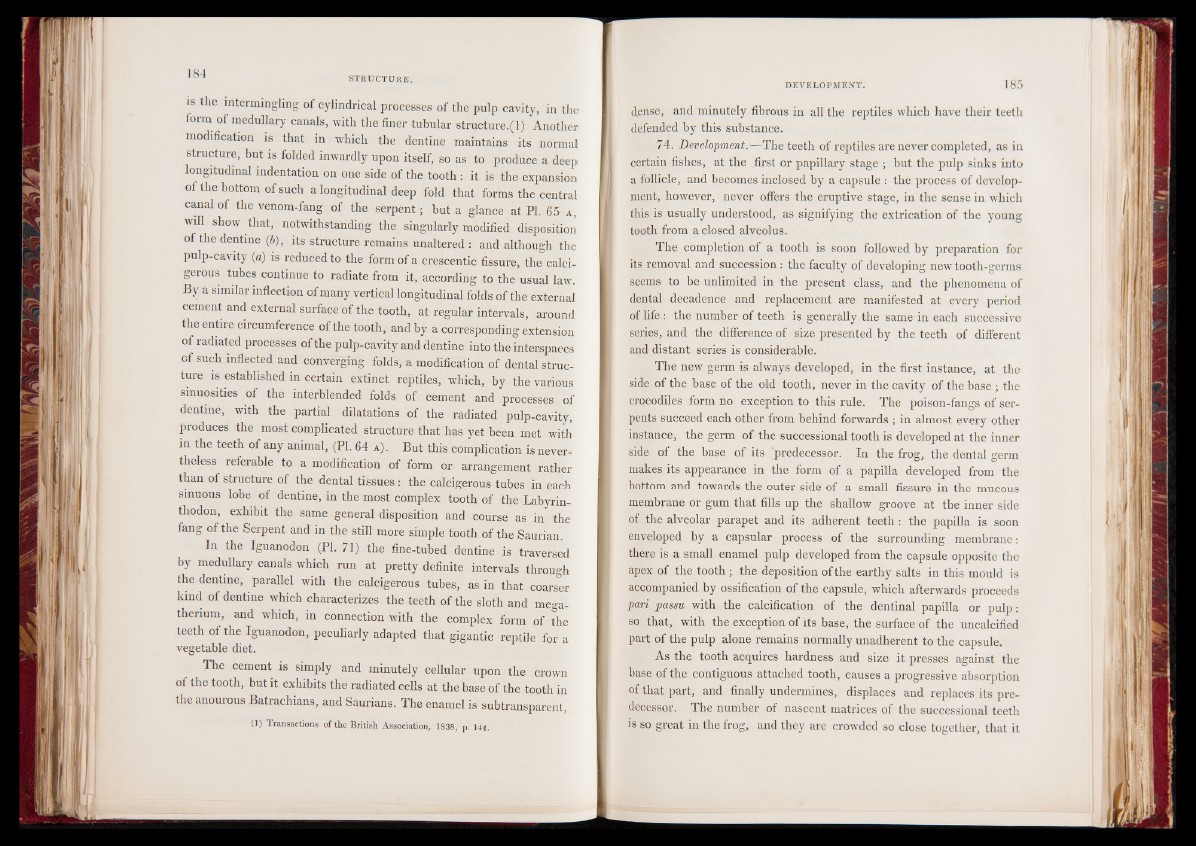
is the intermingling of cylindrical processes of the pulp cavity, in the
form of medullary canals, with the finer tubular structure.(l) Another
modification is that in which the dentine maintains its normal
structure, but is folded inwardly upon itself, so as to produce a deep
longitudinal indentation on one side of the tooth : it is the expansion
of the bottom of such a longitudinal deep fold that forms the central
canal of the venom-fang of the serpent ; hut a glance at PI. 65 a ,
will show that, notwithstanding the singularly modified disposition
of the dentine (6), its structure remains unaltered : and although the
pulp-cavity (a) is reduced to the form of a crescentic fissure, the calci-
gerous tubes continue to radiate from it, according to the usual law.
By a similar inflection of many vertical longitudinal folds of the external
cement and external surface of the tooth, at regular intervals, around
the entire circumference of the tooth, and by a corresponding extension
of radiated processes of the pulp-cavity and dentine into the interspaces
of such inflected and converging folds, a modification of dental structure
is established in certain extinct reptiles, which, by the various
sinuosities of the interblended folds of cement and processes of
dentine, with the partial dilatations of the radiated pulp-cavity,
produces the most complicated structure that has yet been met with
in the teeth of any animal, (PI. 64 a ) . But this complication is nevertheless
referable to a modification of form or arrangement rather
than of structure of the dental tissues : the calcigerous tubes in each
sinuous lobe of dentine, in the most complex tooth of the Labyrin-
thodon, exhibit the same general disposition and course as in the
fang of the Serpent and in the still more simple tooth of the Saurian.
In the Iguanodon (PL 71) the fine-tubed dentine is traversed
by medullary canals which run at pretty definite intervals through
the dentine, parallel with the calcigerous tubes, as in that coarser
kind of dentine which characterizes the teeth of the sloth and megatherium,
and which, in connection with the complex form of the
teeth of the Iguanodon, peculiarly adapted that gigantic reptile for a
vegetable diet.
The cement is simply and minutely cellular upon the crown
of the tooth, but it exhibits the radiated cells at the base of the tooth in
the anourous Batrachians, and Saurians. The enamel is subtransparent,
Cl) Transactions of the British Association, 1838, p. 144.
dense, and minutely fibrous in all the reptiles which have their teeth
defended by this substance.
74. Development.—The teeth of reptiles are never completed, as in
certain fishes, at the first or papillary stage ; but the pulp sinks into
a follicle, and becomes inclosed by a capsule : the process of development,
however, never offers the eruptive stage, in the sense in which
this is usually understood, as signifying the extrication of the young
tooth from a closed alveolus.
The completion of a tooth is soon followed by preparation for
its removal and succession : the faculty of developing new tooth-germs
seems to be unlimited in the present class, and the phenomena of
dental decadence and replacement are manifested at every period
of life : the number of teeth is generally the same in each successive
series, and the difference of size presented by the teeth of different
and distant series is considerable.
The new germ is always developed, in the first instance, at the
side of the base of the old tooth, never in the cavity of the base ; the
crocodiles form no exception to this rule. The poison-fangs of serpents
succeed each other from behind forwards ; in almost every other
instance, the germ of the successional tooth is developed at the inner
side of the base of its 'predecessor. In the frog, the dental germ
makes its appearance in the form of a papilla developed from the
bottom and towards the outer side of a small fissure in the mucous
membrane or gum that fills up the shallow groove at the inner side
of the alveolar parapet and its adherent teeth: the papilla is soon
enveloped by a capsular process of the surrounding membrane:
there is a small enamel pulp developed from the capsule opposite the
apex of the tooth ; the deposition of the earthy salts in this mould is
accompanied by ossification of the capsule, which afterwards proceeds
pari passu with the calcification of the dentinal papilla or pulp:
so that, with the exception of its base, the surface of the uncalcified
part of the pulp alone remains normally unadherent to the capsule.
As the tooth acquires hardness and size it presses against the
base of the contiguous attached tooth, causes a progressive absorption
of that part, and finally undermines, displaces and replaces its predecessor.
The number of nascent matrices of the successional teeth
is so great in the frog, and they are crowded so close together, that it